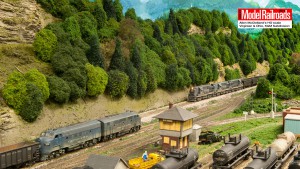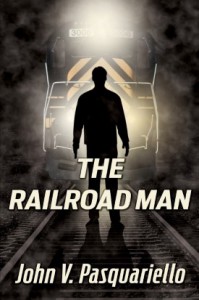What do you think of when you hear the word, “Art?” Do you think of a painter working at an easel dabbing away with his oil paints on his latest creation? Do you think of a singer, belting out her newest tune on stage, or over your radio? Do you think of a great film you loved over the years that was so well done it’s an instant classic. How about just the guy down the street named Art? (Had to through that bad joke in!) Whatever comes to mind, you’d be right. Art takes so many different forms. Even writing is an art form, be it novels, children’s books, short stories or poems. There’s also performance art, where performers carry out some kind of dance-like performance in public.
How about something called model railroading? Do you consider it an art form? Well, despite what some less-informed out there might call playing with trains, it is. And a beautiful one if done properly. Take a look at this picture:
This is a shot of a famous model railroad called the Virginia And Ohio. It is the creation of Mr. Allen McClelland, one of the most prolific model railroaders in the the hobby. Tell me this is not a work of art.
The thing about a model railroad is, even when it gets to this level of completion, it still isn’t finished. It never is! There’s always something to improve, redo, replace. It’s a never-ending campaign of improvement.
So where am I going with this post? Well, as some of you know, my novel, The Railroad Man, has been out now for a little over a year. In that time, I have rewritten and republished it several times, much to my chagrin. What I found was, just like model railroading, even a novel never seems to be finished, even when it is. I have continually updated and upgraded the story since I put it out there. I want to say that will stop, but I can’t. I want to say that I am finished with the story and will now leave it behind and move forward, but doing so would be very disingenuous to you guys. But I’m going to try very hard to leave this latest update of my novel as my last.
The parallels of writing and model railroading also bled through into the novel. How? Well the railroad I set my story against, the Midland Railroad Company, exists only as a figment of my imagination. But I made great pains to bring that railroad to life, if only through my words. Allen McClelland did the same thing. His railroad, The Virginia And Ohio, also does not exist. But most would be hard pressed to determine that the V&O was not a depiction of an actual railroad.
Model railroading follows a number of schools of thought. There are those where an individual puts down a loop of track and runs whatever equipment they want to through a landscape that does not depict any particular town or region. These are whimsical “freelanced” railroads, where the equipment could be a collection of trains from numerous actual railroads and spread over different time frames with no care given to the geographic or chronological relationship of one train to the other. It’s just a free-for-all, “If it runs on tracks, I’ll run it.”
On the other end of the spectrum are your prototype modelers. These are the sticklers, the guys that will operate only what a certain railroad operated through a defined geographical part of that particular railroad during a strict time period, in some cases a single day! These guys are real craftsmen. They scratch build structures to depict actual structures from the actual towns a railroad ran through at the time frame they are modeling. That particular structure could have been knocked down decades ago, but it’s recreated on their layout as faithfully as they can do it. Layouts like this are true works of art. I count myself closer to this end of the spectrum on my own layout, which follows the Santa Fe Railway over Raton Pass, New Mexico in the 1952-56 era. Even so, there are many anachronisms on my layout and some chronological mismatches as well. And none of my structure, save for the few that are offered as kits, will be scaled down replicas of what was actually in Raton during that time frame. There will be “structures” there that will be in the approximate location of the actual ones that were there, but I simply don’t have the time, patience or skill level to scratch build like that.
This leads me to what many consider the middle ground between these two schools of thought. Like I said, my own model railroad falls to the left of the absolute prototype modeler group and towards this middle ground which is called Prototype Freelancing. With Prototype Freelancing, you can “bend the rules” a bit, or twist them until they almost break. It just depends on how much like the real world you want your modeling predilections to be. I chose to model an actual railroad, running only the actual equipment they ran during the time frame I chose, but with a slight mix of trains that ran during what can be best described as a transitional era on the actual Santa Fe railway. The actual railroad experienced a very drastic make-over between 1952 and 1956, and I chose to mix it all together on a layout that captures the “flavor” of the actual locale but doesn’t copy every structure down to the last most minute detail. Allen McClelland went a step further into the middle ground. He created his own railroad prototype to follow, then created an entire history behind it to justify its existence and make it seem like his railroad was actually built and operating in the real world. He even went so far as to draw out his railroad on USGS Topographical Survey maps to insure that even its route was plausible. (Nothing can ruin a model railroaders day more than finding out the line you drew on a map for your fictional railroad runs smack dab into an impenetrable mountain range, making your railroad implausible.)
I had been a fan of the Santa Fe Railway for many decades, ever since I was a boy. It was a legendary railroad that ran some of the greatest trains ever to grace the rails of this country. It even had an Academy Award-Winning song (On the Atchison, Topeka, and the Santa Fe). What wasn’t there to like? Well the fact that the model railroad equipment available at the time wasn’t conducive to modeling a particular railroad all that well. You had to settle for what was out there, even though the equipment wasn’t quite right for the railroad you were modeling. As for locomotives, sure you could “super detail” them, festoon them with dozens of detail after market parts from the hobby shop to make them look closer to the locomotive used by your favorite railroad. But even so, after spending sometimes more money on parts than the basic model was worth, you wound up with a locomotive that still was only about 85% correct. I didn’t like this, and neither did Allen McClelland and others who chose the prototype freelance way. They wanted to have their own railroad with equipment that would be 100% correct because, well, their railroad didn’t really exist, so what was commercially available at the time would be just right for your own railroad.
With this, I moved away from doing the Santa Fe and toward creating a model railroad like the V&O, one that never existed, but could have. I bought reams of topo maps and began marking out a railroad that would be based on a particular favorite of mine, the New York, Susquehanna and Western. (I think by now you’re beginning to see where this is all heading!) I wanted to put the NYSW into a “what if” situation, where its history becomes altered by the changing of a single event, in this case, that the NYSW was never taken over by the Erie in 1898, thus stunting its growth. I then searched for ways to expand it. To make this long story a little shorter, what I wound up with was a railroad that extended west from the NYSW’s end point of Kingston, Pa (Just outside of Wilkes-Barre) through Williamsport and on to a connection with a railroad that failed called the Buffalo and Susquehanna, which gave me a railroad that ran northwestward to Buffalo, NY with an important secondary main that ran due west to a connection with the Baltimore and Ohio Railroad (Yes, the same B&O from the Monopoly board) at Punxsutawney, Pa. This created a railroad that was very plausible, as the guys on Mythbusters would say. And it would have certainly been strong enough to weather the bankruptcy storms of the 1970’s.
In the intervening years, I gave up on trying to create a prototype freelanced model railroad based on my creation. Many factors contributed to this, the chief one being the revolutionary changes in model railroad equipment where prototype specific equipment is now the norm. I returned “Home” so to say to the Santa Fe, and my prototype freelanced NYSW was packed away in another box right next to the one that contained the earlier proto-manuscript for this novel, until I began to write this “new” version of my story. And then, it hit me. Why not use the research I did to create my prototype freelanced model railroad to create the fictional Midland Railroad in my novel, and that as how it came to be. It is a model railroad that exists in the art form of words, not three-dimensions. I had cut it down originally to end back at Scranton and Wilkes-Barre in order to simplify its explanation in the novel, but after the recent take-over of the D&H by the Norfolk Southern, I re-extended my railroad out to what I had originally intended for the Midland to look like. And that’s what prompted me to do the last update.
So, now you see just how model railroading influenced my novel. It was a crazy, long ride that continues to this very day. Buy a copy at Kindle Direct, Smashwords, or in book form at Create Space and see for yourselves. I think you’ll like my little “Prototype Freelanced” Midland Railroad. It is, after all, a work of art! Until next time.








